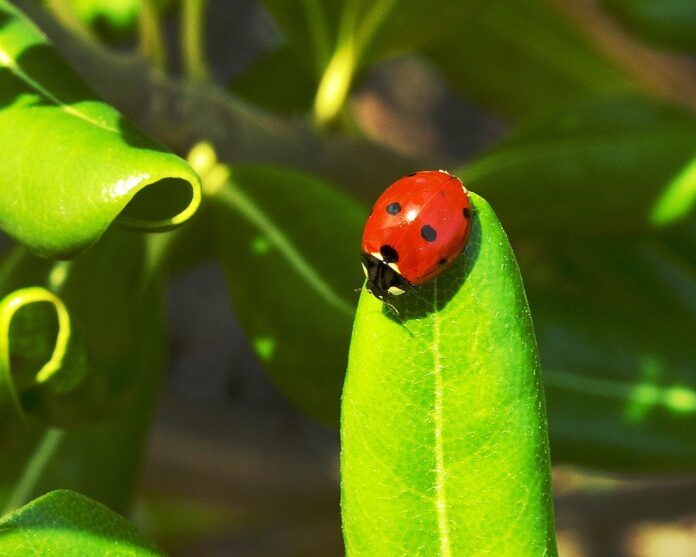
By Rita Bricker[quote_box_right]MAC MASTER GARDENERS PLANT SALE
March 3, 10 a.m.-2 p.m.
Maricopa Agricultural Center, 37860 W. Smith-Enke Road
520-374-6263[/quote_box_right]
Before you smash, spray, or otherwise annihilate that insect in your garden, make sure it is not one of the good guys. There are many insects that can eliminate other destructive pests for us. They are called “beneficial” insects and are of two types, either predators or parasites.
Beneficial predators feed on the insect pest itself. Lady beetles (ladybugs), lacewing larvae, and assassin bugs are examples of predator insects. The praying mantis is another well-known predator in our gardens.
The lady beetle is one of the most famous of the predator insects. These beetles have colorful red, orange, or sometimes yellow front wings speckled with black markings. The adults lay clusters of orange eggs on plants near groups of aphids. After hatching, tiny black and orange larvae feed on aphids in great numbers.
The delicate lacewing is another champion predator insect. The adult lacewings are pale green or light brown insects about a half-inch in size. Their delicate appearance comes from the many veins in their wings, giving them the netted or lacy appearance. The adults feed on nectar and are not predatory themselves, but their larval offspring are. Lacewings lay their pale green eggs on the underside of leaves. The lacewing larvae are tiny and their shape resembles an alligator with large jaws for sucking the juices from small prey and other insect eggs. They consume large numbers of aphids and other insect pests and insect eggs of all kinds.
The praying mantis is perhaps the best-known predator insect. It can be seen sitting on plants or on a wall under a light waiting patiently for another insect to cross its path; then it captures its victim with its spiny front legs and chomps down. Perhaps you have seen a praying mantis egg case about an inch long made of a brownish-gray papery material with numerous compartments glued to a twig or branch. The praying mantis young emerge in the spring looking like miniature versions of their parents.
The eponymous assassin bugs and ambush bugs have their own brand of predatory treachery. Other predatory insects include damsel bugs, big-eyed bugs, minute pirate bugs, syrphid flies, wasps, and dragonflies.
Beneficial parasitic insects differ in their tactics. Typically, they lay their eggs on or within the bodies of their prey. After hatching, the young larvae use the host insect for food. There are parasitic wasps and flies in this category.
One unusual example of a parasitic insect is the eucharitid wasp which lays its eggs in trees. As worker ants search for aphids and other food in the leaves, the parasite larva attaches itself to an ant, hitching a ride back to the ant nest. Once there, the parasite drops off the transport ant and attaches itself to an ant larva to feed.
Isn’t nature fascinating! We owe a lot to these beneficial insects. Let’s protect and encourage them.
Contact a Pinal County Master Gardener at (520) 374-6263 or [email protected]












![Alleged car thief released without charges Phoenix police stop a stolen vehicle on April 20, 2024. [Facebook]](https://www.inmaricopa.com/wp-content/uploads/2024/04/IMG_5040-218x150.jpg)




![City gave new manager big low-interest home loan City Manager Ben Bitter speaks during a Chamber of Commerce event at Global Water Resources on April 11, 2024. Bitter discussed the current state of economic development in Maricopa, as well as hinting at lowering property tax rates again. [Monica D. Spencer]](https://www.inmaricopa.com/wp-content/uploads/2024/04/spencer-041124-ben-bitter-chamber-property-taxes-web-100x70.jpg)